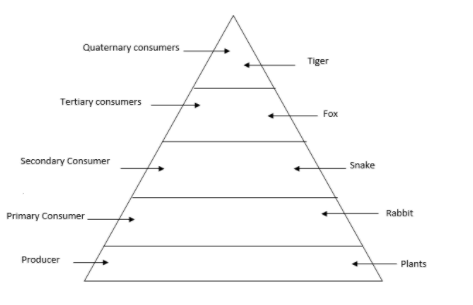
In a food chain, man is
A. Primary and secondary consumer
B. Primary consumer
C. Secondary consumer
D. Producer
Answer
504k+ views
1 likes
Hint:The sequence of transfer of matter and energy in the form of food from organism to organism is called food chain.The flow of energy from producers to top consumers is called energy flow which is unidirectional.
Complete answer:
All the living organisms (plants and animals) must eat some type of food for survival. Plants make their own food through the process called photosynthesis. Using the energy from the sun, water and carbon dioxide from the atmosphere and nutrients. They chemically make their own food. Food chain illustrates how energy flows through a sequence of organisms and how nutrients are transferred from one organism to another. Food chains usually consist of producers, consumers and secondary or tertiary consumer levels. Consumers are defined as primary, secondary or tertiary consumers.

(1) Primary consumers: The primary consumers are the consumers or the organisms that eat producers i.e. who make their own food. They are the next link in the food chain primary consumers, called herbivores can be as small as a grasshopper or as large as an elephant.
(2) Secondary consumer: The secondary consumer or the organisms that feed on the herbivores. These animals are carnivores or meat eaters. Example: Secondary consumers are bats, and fish. Animal eaters are called carnivores.
(3) Tertiary consumers: The tertiary consumers are those who eat secondary consumers. These are bigger animal snakes that eat primary or secondary consumers.
(4) Quaternary consumers: The quaternary consumers are the ones who stand top in the food chain. For example: Tiger, Eagle etc.
Man is both primary and quaternary consumer because a man eats plants like herbivorous and also eats animals like carnivorous.
Therefore, from the above explanation the correct option is (A) Primary and secondary consumer.
Note:A food chain is a chain that shows the relationship between species based upon their feeding. A food chain often begins with a product they consume.
Complete answer:
All the living organisms (plants and animals) must eat some type of food for survival. Plants make their own food through the process called photosynthesis. Using the energy from the sun, water and carbon dioxide from the atmosphere and nutrients. They chemically make their own food. Food chain illustrates how energy flows through a sequence of organisms and how nutrients are transferred from one organism to another. Food chains usually consist of producers, consumers and secondary or tertiary consumer levels. Consumers are defined as primary, secondary or tertiary consumers.

(1) Primary consumers: The primary consumers are the consumers or the organisms that eat producers i.e. who make their own food. They are the next link in the food chain primary consumers, called herbivores can be as small as a grasshopper or as large as an elephant.
(2) Secondary consumer: The secondary consumer or the organisms that feed on the herbivores. These animals are carnivores or meat eaters. Example: Secondary consumers are bats, and fish. Animal eaters are called carnivores.
(3) Tertiary consumers: The tertiary consumers are those who eat secondary consumers. These are bigger animal snakes that eat primary or secondary consumers.
(4) Quaternary consumers: The quaternary consumers are the ones who stand top in the food chain. For example: Tiger, Eagle etc.
Man is both primary and quaternary consumer because a man eats plants like herbivorous and also eats animals like carnivorous.
Therefore, from the above explanation the correct option is (A) Primary and secondary consumer.
Note:A food chain is a chain that shows the relationship between species based upon their feeding. A food chain often begins with a product they consume.
Latest Vedantu courses for you
Grade 10 | CBSE | SCHOOL | English
Vedantu 10 CBSE Pro Course - (2025-26)
School Full course for CBSE students
₹37,300 per year
Recently Updated Pages
Master Class 11 Business Studies: Engaging Questions & Answers for Success

Master Class 11 Economics: Engaging Questions & Answers for Success

Master Class 11 Accountancy: Engaging Questions & Answers for Success

Master Class 11 Computer Science: Engaging Questions & Answers for Success

Master Class 11 English: Engaging Questions & Answers for Success

Master Class 11 Maths: Engaging Questions & Answers for Success

Trending doubts
Which one is a true fish A Jellyfish B Starfish C Dogfish class 11 biology CBSE

Difference Between Prokaryotic Cells and Eukaryotic Cells

1 ton equals to A 100 kg B 1000 kg C 10 kg D 10000 class 11 physics CBSE

One Metric ton is equal to kg A 10000 B 1000 C 100 class 11 physics CBSE

How much is 23 kg in pounds class 11 chemistry CBSE

Net gain of ATP in glycolysis a 6 b 2 c 4 d 8 class 11 biology CBSE




